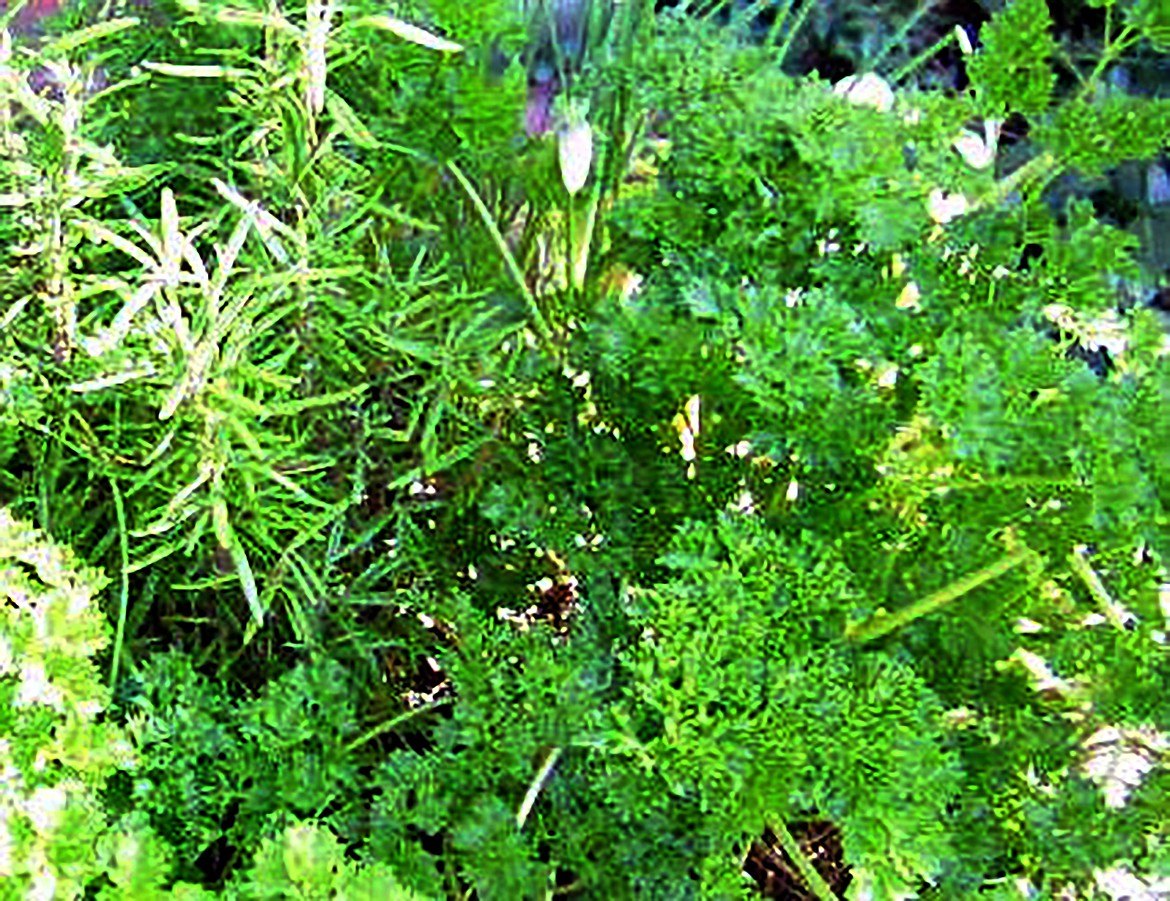Toss the sprays and let veggies, flowers and herbs police their garden
Over the years I have always stressed the benefits of organic, non-chemically adulterated gardens, grown in a healthy, non-dangerous way with the use of companions, compost and special planting options. When the answer is as simple as companion planting – letting fellow veggies and flowers take care of their own, with the added benefits of beauty (and surprises!) via the suggested companions, it’s a win-win situation. I’ve re-organized a list, and today will address the subject with some surprising – and important – possibilities.
I haven’t dwelled on the fact that there are a few herbs and flowers that, while enhancing some plants, can actually be death-dealing enemies to others. So listed are herbal and floral companions that enhance and/or negate healthy growth in the vegetable garden,
This can help with your plans for spring planting as well as crop rotation, since some of them are perennial.
Artemisia (Wormwood): repels Mice; If you don’t have cats, Wormwood’s the answer. Our native Artemisia vulgaris, has pretty grey-green feathery foliage and tiny yellow flowers, and the multitude of attractive cultivars work as well. However, in the veggie garden it is generally not welcome except in the cole crops, where it is death on cabbage loopers and maggots, carrot fly, codling moth and whiteflies. A tea made of rue or wormwood sprayed on plants plagued by aphids, etc., will deter and/or kill them.
Basil: Benefits asparagus, grows well with parsley;
Chamomile: All good - a great companion to cucumbers and beautiful in the patch among the vines. (Cucumbers also love Sunflowers!)
Chives: usually benign, harm beans and peas;
Chrysanthemums: harm lettuce;
Cosmos: White cosmos attracts the valuable lacewing, which eats aphids, thrips and mealybugs. (No report on any of the colored Cosmos);
Dill: harms carrots and tomatoes; however, it enhances cabbage, onions and lettuce;
Fennel: doesn’t like much of anything but actually hurts beans and peppers and should be grown as an ornamental away from veggies, perhaps in a pretty pot at a focal point since it is an enemy to slugs and snails. Its delectable fronds can be used in many dishes. (Coincidentally, fennel is the chosen host plant of the Monarch butterfly – though we don’t have them here – see Parsley);
Garlic: Anathema to beans and peas; a true rose lifesaver – plant it among the rose beds and near the roots of large shrub roses;
Lamium: (dead nettle aka “Snow Nancy” and others in bright colors); plant some among your potato sets for a winning combination (along with equally beneficial gladioli).
Larkspur: Harms beets; benefits beans and cabbage;
Mint: All sorts planted with cabbage and/or tomatoes, and Catnip repels squash bugs.
Mustard: So pretty in the garden, but keep away from the turnips; It benefit beans, grapes and fruit trees in the orchard;
Narcissus: Plant them where you are plagued with moles;
Nicotiana: (ornamental tobacco) is a proven trap plant for flea beetles.
Parsley: Friends – (and beneficial to), tomatoes, asparagus, roses. A vital gift of parsley is that it serves as food for the swallowtail butterfly’s larvae (a striped green/black caterpillar), providing needed sustenance for the beneficial “crawlie” while still maintaining edibles for our own dinner tables. In prior columns I suggested using “sacrifice” parsley as a beneficial ornament in the rose garden, and planting the kitchen parsley in the veggie garden.
Petunias: Beneficial to green and/or wax beans;
Rosemary: Friend to carrots, green, wax and pole beans, tender Rosemary must be taken inside in late fall so “plant” it in the garden in its own pot(s).
Sage: Does great harm to onions; beneficial buddy to almost everything else in the garden:
Strawberries: Friends to spinach and chard - plant in the strawberry bed for mutual benefit.
Tansy: My favorite “bad boy” maligned by county agents everywhere, is a winning trap plant interspersed among your blackberries, raspberries, roses, and (from my long personal experience) peonies. On the negative side, the one plant to which tansy is an enemy is collards. I don’t know too many people that grow them (none, really) but there might be some included in a mesclun seed mix, so take heed. (Just don’t let it grow around cattle!)
Umbellifers: (think umbrella-tops) make great trap crop plants for attracting the “Good Guys” — Caraway, dill, Valerian and Sweet Annie, which attract syrphid flies that prey on many species of aphids. The tiny beneficial wasps that parasitize the eggs of caterpillars, loopers and other destructive worms, also relish a variety of umbellifers including Yarrow, Tansy, Valerian and Angelica.
In the spring, I’ll re-run the usual list of garden veggies and their friends and enemies; for now, this very special — first of a kind list — deals with the relationship of herbs and flowers to the vegetable garden. The beauty of this list (which could be much longer) is that it makes for utterly lovely gardens — flowers, herbs and veggies all together in a mutually beneficial showcase — who could ask for more?
And now, it’s time to pick out a pumpkin for the front porch Halloween visitors and get them ready for Halloween!
Valle Novak writes the Country Chef and Weekend Gardener columns for the Daily Bee. She can be reached at bcdailybee@bonnercountydailybee.com. or by phone at 208-265-4688 between the hours of 8 a.m. to 7 p.m.





